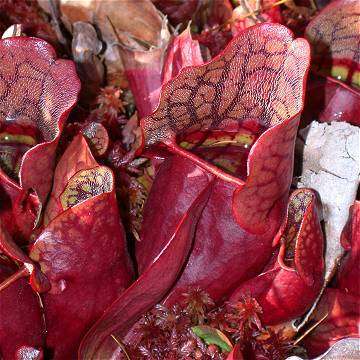

Sarracenia purpurea - (image 1 of 7)
Taxonomy
Family: Sarraceniaceae
Habitat
Sphagnum bogs, peaty barrens, wet pine savannas, flatwoods. Sandy or marly shores.
Associates
In bogs with Andromeda glaucophylla, Carex trisperma, Chamaedaphne calyculata angustifolia, Drosera intermedia, Drosera rotundifolia, Larix laricina, Menyanthes trifoliata minor, Nemopanthus mucronata, Osmunda regalis spectabilis, Potentilla palustris, Rhus vernix, Rhynchospora alba, Vaccinium macrocarpon. In alkaline habitats it grows with Cacalia plantaginea, Oxypolis rigidior, Parnassia glauca, Silphium integrifolium, Valeriana ciliata.
Distribution
Eastern North America. Mostly restricted to the coastal states but westward north of the glacial boundary.
Morphology
Herbaceous perennial. Leaves broadly pitcher-shaped, spreading to weakly ascending, with a broad wing on one side and a hood-like expansion at the summit; this "hood" lined with stiff, downward pointing hairs that prevent trapped insects from escaping. Flowers perfect, solitary on a scape; sepals 5; petals 5, red-purple, incurved, soon deciduous; ovary large, subglobose; style slender at base, extended into 5 rays connected by tissue and forming a 5-angled, umbrella-shaped body with the stigma beneath it at the angles; stamens numerous. Fruit a 5-parted, many seeded capsule.
Notes
Flowers mid May to early June
Wetland indicator: Obligate
The leaves of pitcher plants are passive traps; they do not have any moving parts to snare or entrap insects. Rather, the pitchers lure insects into the leaf and the stiff hair surrounding the lip prevent them from escaping. The soft parts of insects are digested by enzymes and the nutrients absorbed by the plant, while the hard exoskeletons collect at the bottom of the pitcher.
References
Crow, Garrett E and C. Barre Hellquist. 2000. Aquatic and Wetland Plants of
Northeastern North America
Vol. 1. Pteridophytes, Gymnosperms, and Angiosperms: Dicotyledons
The University of Wisconsin Press. Madison, WI
Gleason, Henry A. and A. Cronquist. 1991. Manual of Vascular Plants of
Northeastern United States
and Adjacent Canada. Second Ed.
The New York Botanical Garden. Bronx, NY
Swink, F. and G. Wilhelm. 1994. Plants of the Chicago Region.
Indiana Academy of Science. The Morton Arboretum. Lisle, Illinois.
|
Michael Hough © 2005 |